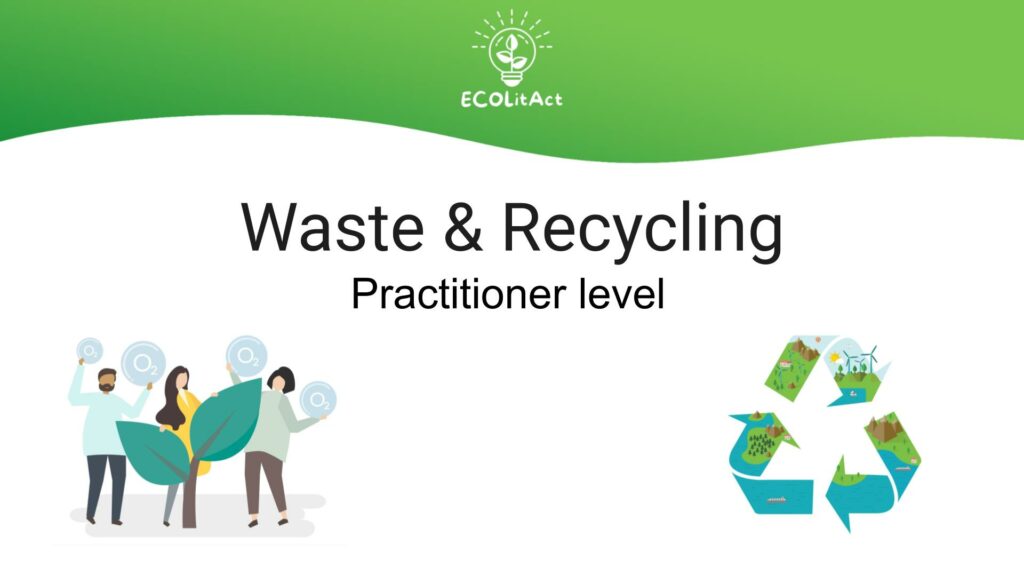Learning objectives | Waste & Recycling terminology | The circular economy | The impact of recycling in preserving the environment | Countering food waste | Assessing your household food waste | Countering fashion waste | Final quiz | Europass

Welcome to the module on circular economy and global waste impact! This module explores the principles of the circular economy and the role of recycling in environmental sustainability. It examines the global impact of waste, focusing on food and fashion waste, and provides practical strategies for waste reduction. Through videos, infographics, reflective activities, and hands-on assessments, you will gain a deeper understanding of how to minimize waste in daily life and contribute to a more sustainable future.
Learning objectives
- Understanding the concept of circular economy and the impact of recycling in preserving the environment
- Analysing and understanding the global impact of fashion waste
- Reflecting on personal shopping behaviors and identify areas for improvement
- Understanding the impact of food waste and learn how to minimise it in everyday life
- Engaging in reflective activities to assess personal waste habits
⏲ The entire lesson takes approximately 2 hours. It is possible to complete the lesson in one sitting or on several occasions.
Waste & Recycling terminology
Before we begin, have a look at the more technical terms you will encounter in the course of the lesson.
The circular economy
Start this module focusing on the circular economy concept. Take a look at the following video of the European Environment Agency to understand how the circular economy model works and how does it benefit our planet.
Now watch the following video named “Repair, re-use and recycle!” developed by the European Parliament.
As you just saw, the circular economy aims to minimize waste and make the most of our resources by reusing, repairing, and recycling materials. This model helps to reduce pollution, conserve energy, and protect ecosystems.
One of the most practical and impactful ways we can support the circular economy in our everyday lives is through recycling.
The impact of recycling in preserving the environment
Recycling is considered to be the most effective method to preserve our earth’s environment. Take a look at the following presentation based on an academic article from “The International Journal of Applied Research” to understand the positive recycling effect on the environment.
Now that you’ve explored how recycling helps close the loop in the circular economy, let’s shift our focus to another major waste issue: food waste.
Food waste not only squanders valuable resources like water, energy, and land – it also contributes significantly to global greenhouse gas emissions. Addressing this issue is crucial to building a more circular and sustainable system.
Countering food waste
Food waste is a major environmental challenge globally. But what is meant by food waste? What falls into this category? Take a look at the following video to understand the significance of food waste.
Worldwide, a third of all food, which amounts to 2.5 billion tonnes yearly, is wasted or lost. This means that if food waste was a country, it would be the third largest greenhouse gas emitter, only surpassed by China and the United States. Watch the following video to understand the extent of this problem globally.
In the following presentation you can find some information on the main causes of food waste.
👉 “Assessing your household food waste” – Hands-on activity
In this module you understood the food waste issue and the importance to minimise it. Now try to assess your household food waste for a week! You can download and use the editable file “Food Waste Assessment Table” to keep record of:
- the type of food wasted;
- the amount of food wasted (in grams);
- the reason why the food was wasted (expiry date, cooked too much, got rotten, etc.);
At the end of the week, you can reflect on the following questions:
- What’s the total amount of food wasted during this week (in grams)?
- Which are the types of food with the highest waste weights?
- What are the main reasons why food becomes waste?
Now that you’ve reflected on food waste and its impact, let’s explore another growing environmental issue: fashion waste.
Just like food, our clothes also go through a life cycle – from production to disposal. The fast fashion industry, in particular, is responsible for high levels of waste, pollution, and resource use. Tackling fashion waste is another important step toward a circular economy.
Countering fashion waste
There is another type of waste that, especially in recent years, is greatly increasing its impact on the health of our planet: the fashion waste. Take a look at the following presentation to get an idea of the impact of fashion waste on the environment.
The cause of this problem is to be found in the phenomenon of fast fashion. Have you never heard of it?! Watch the following video to understand the impact this phenomenon is having on our planet.
The following video by “The economist” focuses on the cost of fast fashion in more details.
As you must know, clothes have their own specific life cycle. Take a look at the following video describing the life cycle of a T-shirt and what impact it has on our environment.
🔔 Action point!
How did these videos make you feel about the costs and impact of fast fashion? Did anything surprise or shock you?
Now reflect on your own shopping habits and wardrobe management. Do you think there are areas where you can make more sustainable choices? If so, what changes could you make?
You can try to use the fashion footprint calculator to calculate your fashion related footprint!
Final quiz
You have completed the module on circular economy and global waste! You can assess what you have learnt by completing the following interactive quiz.
Well done!
You have now completed the practitioner level lesson on waste and recycling!
Showcase your new skills with Europass
You have just completed another step in your learning journey. The skills and knowledge you have gained are valuable – not just for countering climate denialism and contributing to a greener future, but also for opening doors to new opportunities for you! A great way to do this is by adding them to your Europass profile.
Europass is a European Union initiative that helps individuals communicate their skills, qualifications, and experiences clearly and effectively. It consists of several documents, including the Europass CV, which is recognised across Europe and beyond, making it easier for learners to present their qualifications to potential employers or educational institutions.
If you don’t yet have a Europass profile, creating one takes just a few minutes. Get started here. And if you need a little help to set things up, you can take a look at this video tutorial.
For the lesson you have just completed, we encourage you to add the following skills:
- Comprehensive understanding of waste management principles and environmental impact
- Knowledge of recycling systems and practices
- Identification and classification of recyclable materials
- Development of solutions to address fashion waste in the textile industry
- Knowledge of food waste prevention and reduction techniques
- Design and implementation of practical waste reduction strategies for daily life
